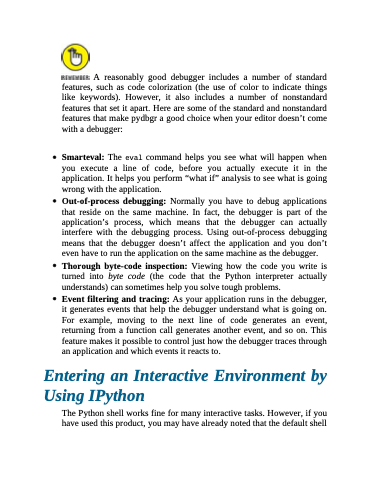Page 436 - Beginning Programming with Pyth - John Paul Mueller
P. 436
A reasonably good debugger includes a number of standard features, such as code colorization (the use of color to indicate things like keywords). However, it also includes a number of nonstandard features that set it apart. Here are some of the standard and nonstandard features that make pydbgr a good choice when your editor doesn’t come with a debugger:
Smarteval: The eval command helps you see what will happen when you execute a line of code, before you actually execute it in the application. It helps you perform “what if” analysis to see what is going wrong with the application.
Out-of-process debugging: Normally you have to debug applications that reside on the same machine. In fact, the debugger is part of the application’s process, which means that the debugger can actually interfere with the debugging process. Using out-of-process debugging means that the debugger doesn’t affect the application and you don’t even have to run the application on the same machine as the debugger.
Thorough byte-code inspection: Viewing how the code you write is turned into byte code (the code that the Python interpreter actually understands) can sometimes help you solve tough problems.
Event filtering and tracing: As your application runs in the debugger, it generates events that help the debugger understand what is going on. For example, moving to the next line of code generates an event, returning from a function call generates another event, and so on. This feature makes it possible to control just how the debugger traces through an application and which events it reacts to.
Entering an Interactive Environment by Using IPython
The Python shell works fine for many interactive tasks. However, if you have used this product, you may have already noted that the default shell


